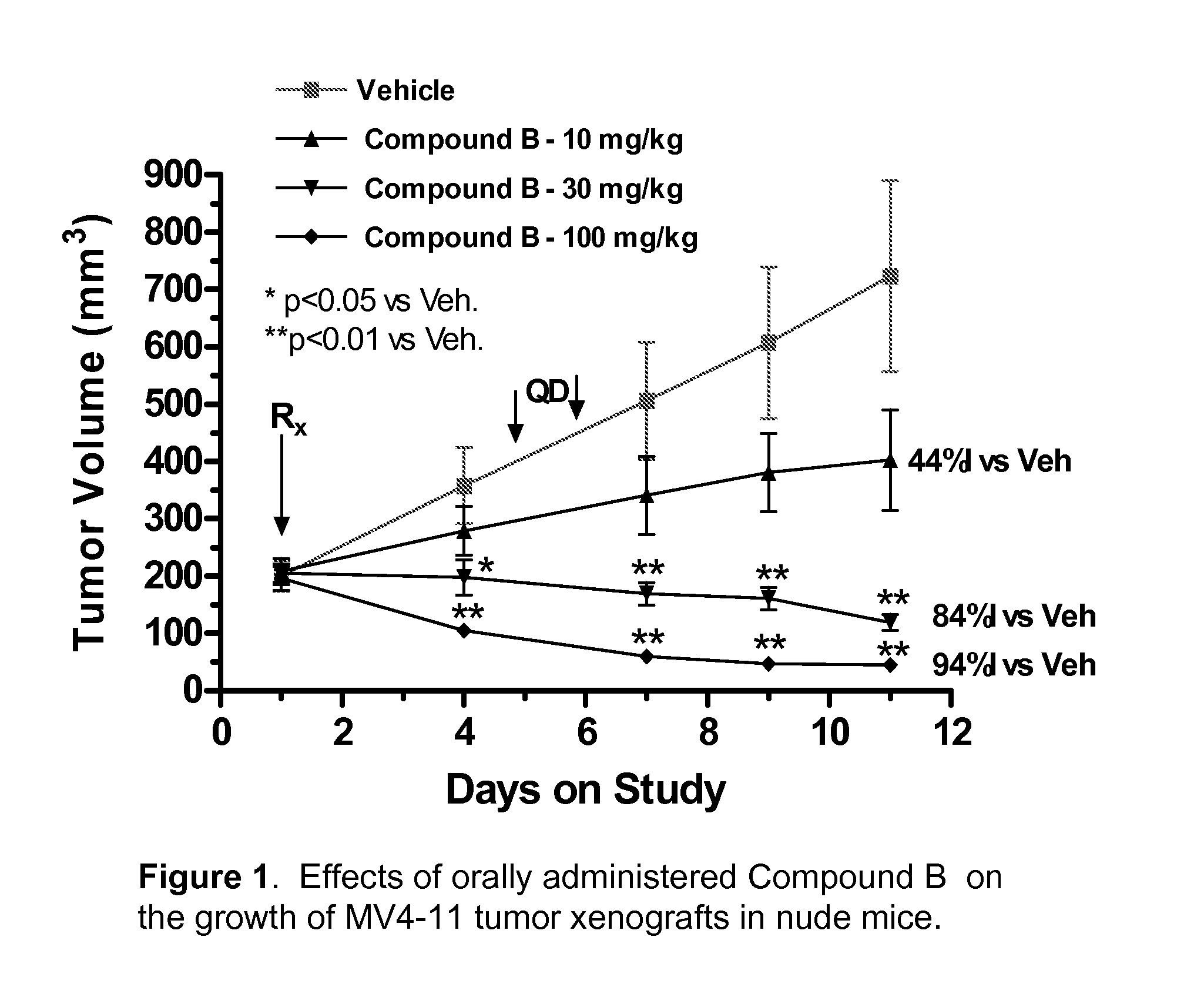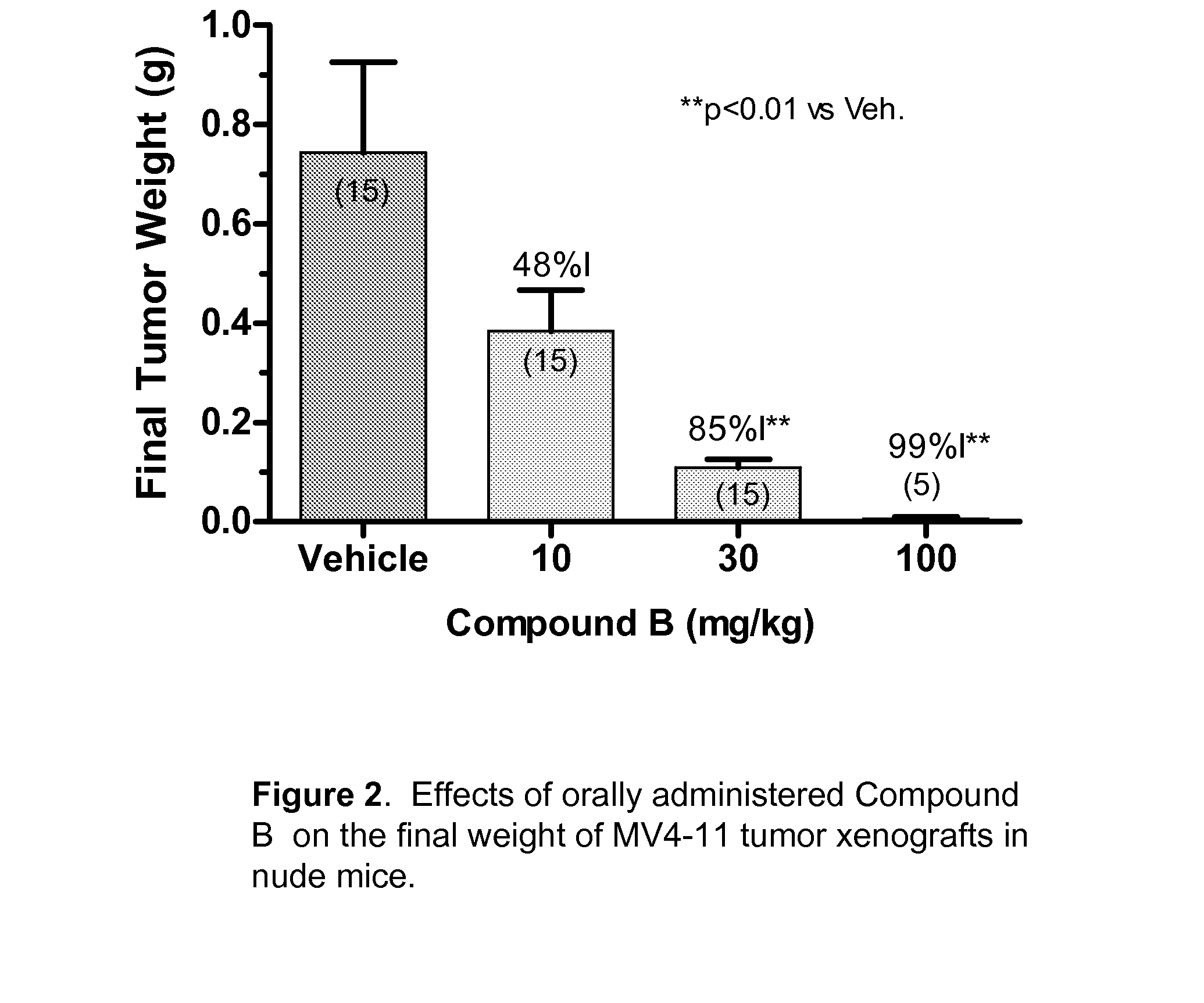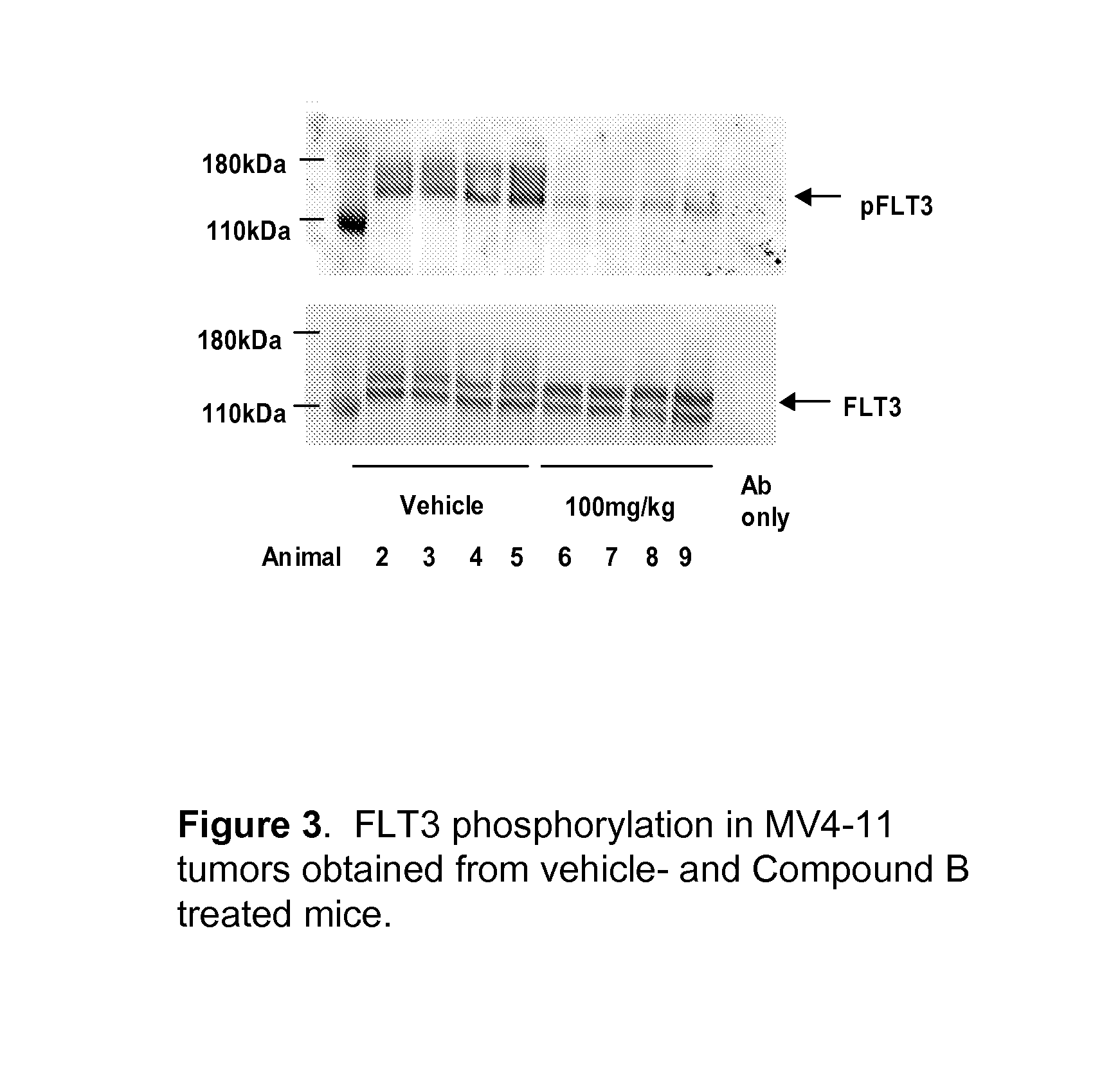Synergistic modulation of flt3 kinase using thienopyrimidine and thienopyridine kinase modulators
a kinase and thienopyrimidine technology, applied in the field of cell proliferative disorders, can solve the problems of high toxicity and resistance of aml, patients with itd mutation, and significant unmet clinical need for aml, and achieve synergistic cytotoxic effects
- Summary
- Abstract
- Description
- Claims
- Application Information
AI Technical Summary
Benefits of technology
Problems solved by technology
Method used
Image
Examples
example 1
(4-Isopropyl-phenyl)-carbamic acid 1-thieno[2,3-d]pyrimidin-4-yl-piperidin-4-yl ester
[0470]
a. 1-Thieno[2,3-d]pyrimidin-4-yl-piperidin-4-ol
[0471]
[0472] A solution of 4-chloro-thieno[2,3-d]pyrimidine (85.3 mg, 0.502 mmol) in isopropanol (2 mL) was treated with 4-hydroxypiperidine (50.6 mg, 0.501 mmol). After stirring at 100° C., overnight, the reaction was cooled to RT, partitioned between DCM (20 mL) and H2O (20 mL). The organic phase was dried over Na2SO4 and concentrated in vacuo to afford the title compound as a solid (67.8 mg, 58%), which was used in the next step without further purification or characterization.
b. (4-Isopropyl-phenyl)-carbamic acid 1-thieno[2,3-d]pyrimidin-4-yl-piperidin-4-yl ester
[0473]
[0474] To a solution of 1,1′-carbonyldiimidazole (23.5 mg, 0.145 mmol) in DCM (1 mL) was added 4-isopropylaniline (19.6 mg, 0.145 mmol). After stirring at 0° C. for 2 h, 1-thieno[2,3-d]pyrimidin-4-yl-piperidin-4-ol (34.1 mg, 0.145 mmol), as prepared in the previous step, was ...
example 2
(4-Isopropoxy-phenyl)-carbamic acid 1-thieno[2,3-d]pyrimidin-4-yl-piperidin-4-yl ester
[0475]
[0476] To a solution of 1,1′-carbonyldiimidazole (23.3 mg, 0.144 mmol) in DCM (1 mL) was added 4-isopropoxyaniline (21.7 mg, 0.144 mmol). After stirring at 0° C. for 2 h, 1-thieno[2,3-d]pyrimidin-4-yl-piperidin-4-ol (33.7 mg, 0.143 mmol), as prepared in Example 1a, was added and stirred at RT. After 2 h, DMAP (17.6 mg, 0.144 mmol) was added and stirred at 85° C. overnight. The reaction was then cooled to RT, partitioned between DCM (10 mL) and H2O (10 mL). The organic phase was dried over Na2SO4 and concentrated in vacuo. Purification by prep tlc (1:1 Hexane / EtOAc) afforded the title compound as a light green solid (8.4 mg, 14%). 1H NMR (300 MHz, CDCl3) δ 8.7 (br s, 1H), 7.44 (br m, 1H), 7.29 (m, 3H), 6.85 (m, 2H), 6.56 (br s, 1H), 5.09 (m, 1H), 4.48 (heptet, 1H), 4.17 (m, 2H), 3.75 (m, 2H), 2.11 (m, 2H), 1.87 (m, 2H), 1.31 (d, 6H). LC / MS (ESI): calcd mass 412.2, found 413.2 [M+1]+.
example 3
(4-Isopropyl-phenyl)-carbamic acid 1-thieno[2,3-d]pyrimidin-4-yl-pyrrolidin-3-yl ester
[0477]
a. (4-Isopropyl-phenyl)-carbamic acid 4-nitro-phenyl ester
[0478]
[0479] To a solution of 4-isopropylaniline (3.02 g, 22.3 mmol) in DCM (40 mL) and pyridine (10 mL) was added 4-nitrophenyl chloroformate (4.09 g, 20.3 mmol) portionwise with stirring over ˜30 sec with brief ice-bath cooling. After stirring at rt for 1 h, the homogeneous solution was diluted with DCM (100 mL) and washed with 0.6 M HCl (1×250 mL), 0.025 M HCl (1×400 mL), water (1×100 mL), and 1 M NaHCO3 (1×100 mL). The organic layer was dried (Na2SO4) and concentrated to give the title compound as a light peach-colored solid (5.80 g, 95%). 1H NMR (300 MHz, CDCl3) δ 8.28 (m, 2H), 7.42-7.32 (m, 4H), 7.23 (m, 2H), 6.93 (br s, 1H), 2.90 (h, J=6.9 Hz, 1H), 1.24 (d, J=6.9 Hz, 6H). LC / MS (ESI): calcd mass 300.1, found 601.3 (2MH)+.
b. (4-Isopropyl-phenyl)-carbamic acid 1-thieno[2,3-d]pyrimidin-4-yl-pyrrolidin-3-yl ester
[0480]
[0481] A m...
PUM
| Property | Measurement | Unit |
|---|---|---|
| Volume | aaaaa | aaaaa |
| Electric potential / voltage | aaaaa | aaaaa |
| Electric potential / voltage | aaaaa | aaaaa |
Abstract
Description
Claims
Application Information
 Login to View More
Login to View More - R&D
- Intellectual Property
- Life Sciences
- Materials
- Tech Scout
- Unparalleled Data Quality
- Higher Quality Content
- 60% Fewer Hallucinations
Browse by: Latest US Patents, China's latest patents, Technical Efficacy Thesaurus, Application Domain, Technology Topic, Popular Technical Reports.
© 2025 PatSnap. All rights reserved.Legal|Privacy policy|Modern Slavery Act Transparency Statement|Sitemap|About US| Contact US: help@patsnap.com



